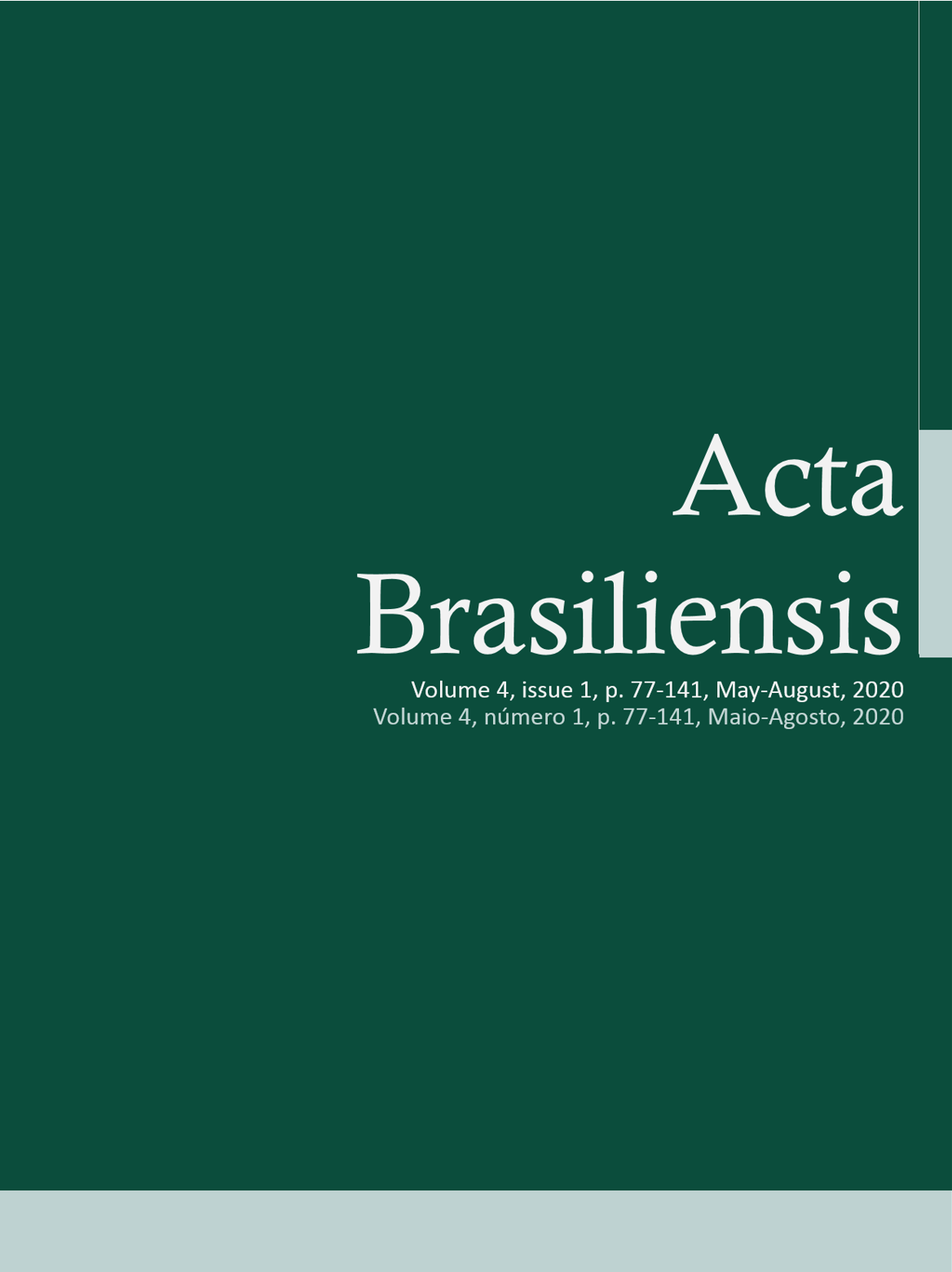First record of microfilariae in Antilophia galeata (Aves: Pipridae)
Abstract
Filarid nematodes are transmitted by arthropod vectors. In the vertebrate host, they inhabit the cardiovascular, pulmonary, and lymphatic system. Although most bird infections are not considered pathogenic, there may be an impact on fitness. Blood smears were performed to verify the intensity of the infection and to morphometrically analyse and describe the microfilariae found in individuals of Antilophia galeata captured in a fragment of the Cerrado forest. The microfilariae were photographed, and morphometry analysis was performed using the ImageJ software. One individual was infected (14.2%; n = 7) but with a high intensity of infection (42 microfilariae). It is suggested that the microfilariae found belong to the genus Eufilaria spp., since all specimens presented the diagnostic characteristics of the taxon (absence of sheath, pointed tail, and length less than 200 μm). This is the first time that microfilariae parasitising A. galeata have been recorded. Considering that microfilariae records are rare in Brazilian wild birds, this record may be useful to support further studies and contribute to the understanding of the conservation of the host species.
Downloads
References
Atkinson, C. T. & LA Pointe, D. A. (2009). Introduced avian diseases, climate change, and the future of Hawaiian honeycreepers. Journal of Avian Medicine and Surgery, 23(1), 53-63. doi: 10.1647/2008-059.1
Baesse, C. Q., Tolentino, V. C. M., Morelli, S. & Melo, C. (2019). Effect of urbanization on the micronucleus frequency in birds from forest fragments. Ecotoxicology and Environmental Safety, 171, 631-637. doi: 10.1016/j.ecoenv.2019.01.026
Bartlett, C. M. (2009). Filarioid Nematodes. In: C. T Atkinson, N. J. Thomas & D. B. Hunter (Orgs.), Parasitic Diseases of Wild Birds (pp. 439-462). Ames: Wiley-Blackwell Publishing.
Benedikt, V., Barus. V., Capek, M., Havlicek, M. & Literak I. (2009). Blood parasites (Haemoproteus and microfilariae) in birds from the Caribbean slope of Costa Rica. Acta Parasitologica, 54(3), 197-204. doi: 10.2478/s11686-009-0043-1
Braga, E. M., Belo, N. O., Pinheiro, R. T., 2010. Técnicas para estudos de hemoparasitos em aves. In: Von Matter, S., Straube, F.C., Accordi, I., Piacentini, V., Candido-Jr, J. F. (Orgs.), Ornitologia e Conservação: Ciência Aplicada, Técnicas de Pesquisa e Levantamento (Cap. 17, pp. 395-411). Rio de Janeiro: Technical Books.
Brum, W.M., Pereira, M.A.V.C., Vita, G.F., Ferreira, I., Mello, E.R., Aurnheimer, R.D. C.M. & Padua, E.D. (2016). Parasitismo em aves silvestres residentes e migratórias da Ilha da Marambaia, Estado do Rio de Janeiro. Pesquisa Veterinária Brasileira, 36, 1101-1108. doi: 10.1590/s0100-736x2016001100008
Clark, N. J., Wells, K., Dimitrov, D. & Clegg S. M. (2016). Co-infections and environmental conditions drive the distributions of blood parasites in wild birds. Journal of Animal Ecology, 85(6), 1461-1470. doi: 10.1111/1365-2656.12578
Dreyer, G. & Dreyer, P. (2001). Diagnóstico Laboratorial da Filariose Bancroftiana. In G. A. De Carli (Org.), Parasitologia clínica: seleção de métodos e técnicas de laboratório para o diagnóstico das parasitoses humanas (Cap. 19, pp. 373-394). São Paulo: Editora Atheneu.
Edler, R., Goymann, W., Schwabl, I. & Friedl, T. W. (2011). Experimentally elevated testosterone levels enhance courtship behaviour and territoriality but depress acquired immune response in red bishops Euplectes orix. Ibis, 153(1), 46-58. doi: 10.1111/j.1474-919X.2010.01075.x
Fecchio, A., Lima, M. R., Silveira, P., Braga, É. M. & Marini, M. Â. (2011). High prevalence of blood parasites in social birds from a neotropical savanna in Brazil. Emu-Austral Ornithology, 111(2), 132-138. doi: 10.1071/MU10063
Haas, M., Baruš, V., Benedikt, V. & Literák, I. (2011). Microfilariae in birds in the Czech Republic, including a note on adult nematodes Eufilaria delicata in a song thrush Turdus philomelos. Parasitology Research, 109(3), 645-655. doi: 10.1007/s00436-011-2297-4
Huang, Y. L., Tsai, S. S., Thongchan, D., Khatri-Chhetri, R. & Wu, H. Y. (2017). Filarial nematode infection in eclectus parrots (Eclectus roratus) in Taiwan. Avian Pathology, 46(2), 188-194. doi: 10.1080/03079457.2016.1237014
Kučera, J. (1981). Blood parasites of birds in central Europe.1. Survey of literature. The incidence in domestic birds and general remark to the incidence in wild birds. Folia Parasitologica, 28, 13-22.
Law, J. M., Tully, T. N. Stewart, T.B. (1993). Verminous encephalitis apparently caused by the filarioid nematode Chandlerella quiscali in emus (Dromaius novaehollandiae). Avian Diseases 37: 597-601.
Marçal, B. F. & Lopes, L. E. (2019). Breeding biology of the Helmeted Manakin Antilophia galeata in an ecotone between the Atlantic Forest and the Cerrado. Ornithology Research, 27(1), 1-9. doi: 10.1007/BF03544440
Mckeand, J. B. (1998). Molecular diagnosis of parasitc nematodes. Parasitology, 117(7), 86-96. doi: 10.1017/S0031182099004096
Muñoz-García, C. I., López-Díaz, O., Osorio-Sarabia, D., Martínez-Hernández, F., Villalobos, G., Isaak-Delgado, A. B. & Pleite, C.M.C. (2018). New insights into the clinic histopathological and molecular features of Pelecitus (Filarioidea: Onchocercidae) from a raptor bird. Parasitology research, 117(10), 3319-3325. doi: 10.1007/s00436-018-6009-1
Sebaio, F., Braga, É. M., Branquinho, F., Fecchio, A. & Marini, M.Â. (2012). Blood parasites in passerine birds from the Brazilian Atlantic Forest. Revista Brasileira de Parasitologia Veterinária, 21(1), 7-15. doi: 10.1590/S1984-29612012000100003
Silva, C. & Carmo, R. S. (2015). Descrição do ninho, ovo e ninhego da choca-do-planalto Thamnophilus pelzelni Hellmayr, 1924 (Passeriformes: Thamnophilidae) no Parque Nacional Serra de Itabaina, Sergipe, Brasil. Atualidades Ornitológicas, 185, 4-6.
Silva, J. M. C. (1988). Aspectos da Ecologia e Comportamento de Formicivora grisea (Boddaert, 1789) (Aves: Formicariidae) em ambientes amazônicos. Revista Brasileira de Biologia, 48, 797-805.
Sick, H. (2001). Ornitologia brasileira. Rio de Janeiro: Editora Nova Fronteira.
Silva, A. M. & Melo, C. (2011). Frugivory and seed dispersal by the helmeted manakin (Antilophia galeata) in forests of Brazilian Cerrado. Ornitología Neotropical, 22, 69-77.
Silveira, P., Belo, N. O., Rodello, D., Pinheiro, R. T. & Braga, É. M. (2010). Microfilariae infection in wild birds from the Brazilian Cerrado. Journal of Wildlife Diseases, 46(4), 1305-1309. doi: 10.7589/0090-3558-46.4.1305
WikiAves. (2019). Soldadinho (Antilophia galeata). WikiAves, a Enciclopédia das Aves do Brasil.
WikiAves. (2020). Batuqueiro (Saltator atricollis). WikiAves, a Enciclopédia das Aves do Brasil.
Willis, E. O. & Oniki, Y. (1988). Nesting of the Rusty-backed Antwren, Formicivora rufa (Wied 1831) (Aves, Formicariidae). Revista Brasileira de Biologia, 48, 635-637.






